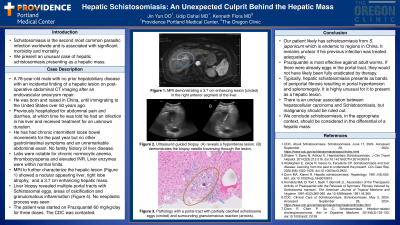Tuesday Poster Session
Category: Liver
P4780 - Hepatic Schistosomiasis: An Unexpected Culprit Behind the Hepatic Mass
Tuesday, October 29, 2024
10:30 AM - 4:00 PM ET
Location: Exhibit Hall E

Has Audio

Jin Yun, DO
Providence Portland Medical Center
Portland, OR
Presenting Author(s)
Jin Yun, DO1, Udip Dahal, MD1, Kenneth Flora, MD2
1Providence Portland Medical Center, Portland, OR; 2The Oregon Clinic, Portland, OR
Introduction: Schistosomiasis is the second most common parasitic infection worldwide and is associated with significant morbidity and mortality due to complications resulting from hepatic fibrosis. We present an unusual case of schistosomiasis presenting as a hepatic mass.
Case Description/Methods: A 78-year-old male with no prior hepatobiliary disease was referred to an outpatient gastroenterologist for evaluation of a hepatic lesion found incidentally on post-operative abdominal CT imaging after an endovascular aneurysm repair. Patient was born and raised in China, until immigrating to the United States over 50 years ago. He has since traveled back to China. He was hospitalized shortly after his last trip to China for abdominal pain and diarrhea, at which time was told he had an infection in his liver and received treatment for unknown duration. He has had chronic intermittent loose stools for the past year but no other gastrointestinal symptoms and an unremarkable abdominal exam. He does not have a family history of liver disease. Initial labs were notable for chronic normocytic anemia, thrombocytopenia and elevated INR. Liver enzymes were within normal limits. He underwent MRI to further characterize the hepatic lesion. It showed a nodular appearing liver and a 3.7 cm enhancing hepatic mass. Subsequent biopsy revealed multiple portal tracts with Schistosomal ova and areas of calcification and granulomatous inflammation. No neoplastic process was seen. The patient was started on Praziquantel by infectious disease and the CDC was contacted.
Discussion: Schistosomiasis affects more than 200 million people globally and remains a significant public health issue. Though cases in the United States are uncommon, low index of suspicion and inadequate screening of patients who travel to or from endemic areas can result in chronic infection with complications. Our patient was appropriately diagnosed, but it remains unclear whether he was inadequately treated for acute infection of S. japonicum, which is endemic to regions in China, during his initial hospitalization. If there were already eggs in the portal tract, they would not have likely been eradicated by therapy. Typically, hepatic schistosomiasis presents as bands of periportal fibrosis resulting in portal hypertension and splenomegaly. It is highly unusual for it to present as a hepatic lesion, as was observed in our patient. We conclude schistosomiasis, in the appropriate context, should be considered in the differential of a hepatic mass.
Disclosures:
Jin Yun, DO1, Udip Dahal, MD1, Kenneth Flora, MD2. P4780 - Hepatic Schistosomiasis: An Unexpected Culprit Behind the Hepatic Mass, ACG 2024 Annual Scientific Meeting Abstracts. Philadelphia, PA: American College of Gastroenterology.
1Providence Portland Medical Center, Portland, OR; 2The Oregon Clinic, Portland, OR
Introduction: Schistosomiasis is the second most common parasitic infection worldwide and is associated with significant morbidity and mortality due to complications resulting from hepatic fibrosis. We present an unusual case of schistosomiasis presenting as a hepatic mass.
Case Description/Methods: A 78-year-old male with no prior hepatobiliary disease was referred to an outpatient gastroenterologist for evaluation of a hepatic lesion found incidentally on post-operative abdominal CT imaging after an endovascular aneurysm repair. Patient was born and raised in China, until immigrating to the United States over 50 years ago. He has since traveled back to China. He was hospitalized shortly after his last trip to China for abdominal pain and diarrhea, at which time was told he had an infection in his liver and received treatment for unknown duration. He has had chronic intermittent loose stools for the past year but no other gastrointestinal symptoms and an unremarkable abdominal exam. He does not have a family history of liver disease. Initial labs were notable for chronic normocytic anemia, thrombocytopenia and elevated INR. Liver enzymes were within normal limits. He underwent MRI to further characterize the hepatic lesion. It showed a nodular appearing liver and a 3.7 cm enhancing hepatic mass. Subsequent biopsy revealed multiple portal tracts with Schistosomal ova and areas of calcification and granulomatous inflammation. No neoplastic process was seen. The patient was started on Praziquantel by infectious disease and the CDC was contacted.
Discussion: Schistosomiasis affects more than 200 million people globally and remains a significant public health issue. Though cases in the United States are uncommon, low index of suspicion and inadequate screening of patients who travel to or from endemic areas can result in chronic infection with complications. Our patient was appropriately diagnosed, but it remains unclear whether he was inadequately treated for acute infection of S. japonicum, which is endemic to regions in China, during his initial hospitalization. If there were already eggs in the portal tract, they would not have likely been eradicated by therapy. Typically, hepatic schistosomiasis presents as bands of periportal fibrosis resulting in portal hypertension and splenomegaly. It is highly unusual for it to present as a hepatic lesion, as was observed in our patient. We conclude schistosomiasis, in the appropriate context, should be considered in the differential of a hepatic mass.
Disclosures:
Jin Yun indicated no relevant financial relationships.
Udip Dahal indicated no relevant financial relationships.
Kenneth Flora indicated no relevant financial relationships.
Jin Yun, DO1, Udip Dahal, MD1, Kenneth Flora, MD2. P4780 - Hepatic Schistosomiasis: An Unexpected Culprit Behind the Hepatic Mass, ACG 2024 Annual Scientific Meeting Abstracts. Philadelphia, PA: American College of Gastroenterology.
